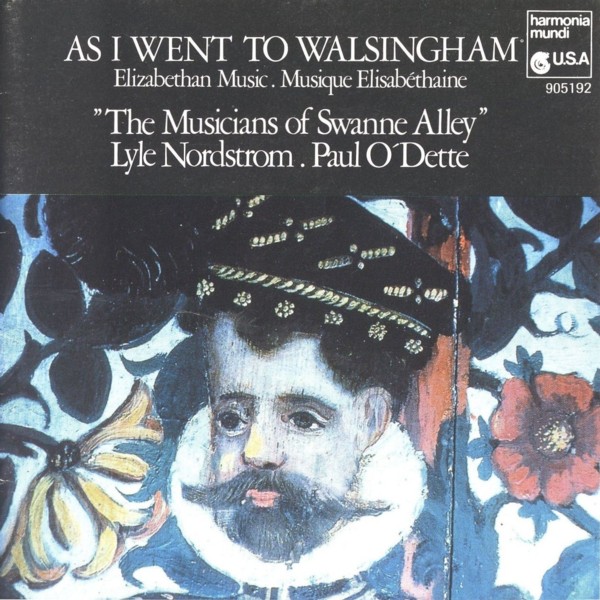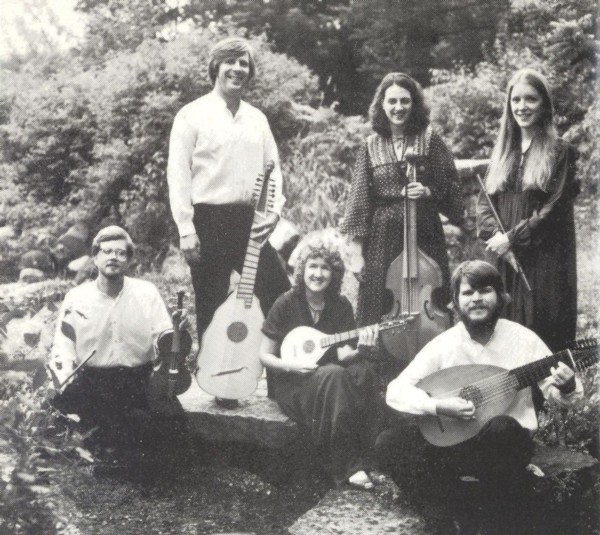
harmonia mundi USA, HMC 905192
1987
Anonymous
1. WALSINGHAM GALLIARD English consort [1:34]
John Johnson (ca. 1540-1594)
2. A PAVEN TO DELIGHT English consort [4:12]
Richard Allison (d. 1606)
3. THE LADY FRANCES SIDNEYS ALMAYNE English consort [1:36]
(violin,flute, lute, cittern, bandora, bas viol)
William Byrd (1543-1623)
4. DEAR LIFE soprano and viols [3:12]
(Text by Sir Philip Sidney)
Anonymous
5. MY TRUE LOVE HATH MY HEART soprano and lute [2:18]
(Text by Sir Philip Sidney)
John Johnson
6. AS I WENT TO WALSINGHAM lute solo [2:46]
William Byrd
7. O LORD, HOW VAIN ARE ALL OUR FRAIL DELIGHTS soprano and viols [6:21
(Text by Sir Philip Sidney)
John Johnson ?
8. GO MERELY WHEELE lute duet [2:33]
Richard Allison
9. GO FROM MY WYNDOE English consort [3:42]
10. MR. ALLISONS ALMAYNE English consort [1:13]
Anonymous
11. AS I WENT TO WALSINGHAM soprano solo [0:24]
Edward Collarde (d. ca. 1599)
12. WALSINGHAM lute solo [3:33]
Guillaume Tessier (fl. ca. 1582)
13. IN A GROVE MOST RICH OF SHADE soprano and lute [5:01]
(Text by Sir Philip Sidney)
Richard Allison
14. THE LADY FRANCES SIDNEYS GOODNIGHT English consort [3:35]
Anonymous
15. SQUIERS GALLIARD English consort [1:26]
16. WALSINGHAM lyra-viol [2:57]
17. PRIMIERO English consort [4:08]
William Byrd
18. COME TO ME, GRIEF, FOREVER soprano and viols [6:17]
(Elegy for Sir Philip Sidney)
Anthony Holborne (d. 1602)
19. WALSINGHAM lute solo [0:48]
THE MUSICIANS OF SWANNE ALLEY
Lyle Nordstrom & Paul O'Dette
David Douglass, violin, viol
Lyle Nordstrom, bandora, lute (duet), viol
Patricia Adams Nordstrom, cittern, viol
Paul O'Dette, lute (solo & consort)
Christel Thielmann, viols, lyra-viol
Emily Van Evera, soprano, flutes
Recorded March 1986, Bethel United Church of Christ, Michigan
Engineer: Peter McGrath
Producer: Robina Young
Editing assistance: Hugh B. Davies, Shirley Walker
Cover: Elixabethan Music Party, from Frieze, Gilling Castle, England
reproduced by kind permission of the Abbot, Ampleforth Monastery
Atelier Relations, Arles
harmonia mundi Ⓟ 1987

WALSINGHAM: A TUNE. A FAMILY. A STATESMAN. A HERO
By the time Elizabeth the First began her long and successful reign in
1588, the Walsingham family name had already been long associated with
service and dedication. Perhaps not by coincidence, "Walsingham" is
also the popular name given to a ballad tune which enjoyed its heyday
in the decades around 1600. This recording is a musical exploration of
both the family and the tune which were so prominent during England's
"Golden Age."
The most famous Walsingham is Sir Francis (ca. 1530-1590), Queen
Elizabeth's tireless chief administrator and Secretary of State. Master
negotiator, adroit linguist, loyal friend, dedicated Catholic foe, spy
master, and arts patron, he was, in short, the paradox his age demanded
—the balanced Renaissance gentleman, equally at home with the
skills of politics and the skills of the arts.
Of equal importance to this recording is his protégé, Sir
Philip Sidney (1554-1586), the charismatic courtier whose disarming
brilliance became legendary throughout Europe, but whose life itself
was a paradox. He was hailed as the premier courtier of his day, but
had a temperamental distaste for court life. He was regarded as a
statesman and soldier by his contemporaries, but was sent on few
missions, and saw little action in battle. Remembered as a leader of
the English poetic rebirth, he saw his work only as a pleasantly
challenging intellectual diversion. Ironically, when Sidney died at age
32, in a skirmish against the Spanish, his bright promise in the
political realm was largely unfulfilled, but his legacy to English
literature, not at all part of his public legend, endures until today.
The warm relationship between Walsingham and Sidney was further
cemented when Sir Philip married Walsingham's daughter, Lady Frances,
in 1583. Little is known about her today, but she appears to have been
less politically inclined than some of her famous contemporaries, such
as Bess of Harwick. Contemporary references are to her great beauty and
gentle nature, and following Sidney's death, she married Robert
Devereux, the famous Earl of Essex.
THE WALSINGHAM CONSORT BOOKS
PHILIP SIDNEY AND WILLIAM BYRD
In the Fairie Queene, Edmund Spenser refers to Sir Francis as
"the Great Maecenas of this age," and in comparing him to the
quintessential arts patron of antiquity, confirms the importance of
Walsingham's patronage. The most tangible musical evidence of this left
to us today is the collection known as the Walsingham Consort Books.
This incomplete set of part-books copied for the Walsingham family
contains portions of about 32 works for "English consort," that
combination of treble viol (violin), flute, lute, bass viol, cittern
and pandora which was such a popular part of Elizabethan chamber music.
Traditionally, these pieces were written in a three-part dance form,
with lute divisions on each sectional repeat. The consort lessons found
in the Walsingham books also survive with written divisions for the
flute and violin, and particularly fine examples of this special
treatment are found in the consorts by Richard Allison. Allison further
displays his innovative bent in the singular set of variations on the
ballad tune, Go from my wyndoe. It is possible that Allison's
imaginative hand is also at work in the unattributed Primiero,
with its almost programmatic depiction of a battle.
Of the songs found on this recording, all except one are settings of
verse written by Sir Philip Sidney in the last seven years of his life.
My true love bath my heart is taken from the famous Arcadia,
while In a grove most rich of shade is found in Sydney's
pastoral sonnet cycle, Astrophel and Stella. The "Astrophel"
story of unrequited love chronicles one of the unresolved mysteries of
Sidney's life, his supposed love affair with the Lady Rich, Penelope
Devereux. There seems to be no doubt that Penelope is the "Stella" of
the poems, but the depth of Sidney's passion is less clear.
It is ironic that William Byrd, a persistently successful Catholic in
the midst of Protestant ferment, set more Sidney poems than any other
composer. Beyond this, Byrd also wrote three "funeral" songs in memory
of the Protestant hero. One of these is Come to me, grief, for ever,
whose text well represents the sentiments expressed in the exceptional
flood of elegies which followed Sidney's death. There was apparently
something in the life of this man that touched Elizabeth's subjects,
and their hopes for the future of England. With his death, some of this
died as well.
PATRICIA ADAMS NORDSTROM